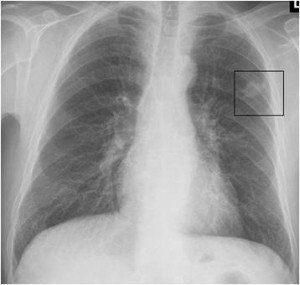Patient Resources
I have a spot in my lung. Do I have lung cancer?
What is Pulmonary Nodule?
You may have been told by your doctor to have a pulmonary nodule. This means that a spot that is not normal tissue or blood vessels has been found in your lung. This usually happens when you have a routine chest X-Ray taken or when you have a CT scan of your chest taken for other reasons.Pulmonary nodules may be due to a number of disorders. These may include a scar in the lung (from an old infection), an abnormal blood vessel or a non-cancerous growth. Unfortunately, some of these nodules may turn out to be due to cancer.
What happens next?
Once you are diagnosed with a pulmonary nodule, your doctor may refer you to a respiratory physician, a specialist in the diagnosis and treatment of lung disorders. The first thing the respiratory physician will ask for is all previous X-rays or CT scans you may have had. If the nodule has been there for several years, and has not changed in size or appearance, it is not likely to be cancerous and no further evaluation may be needed. If there are no previous X-rays for comparison, or the nodule has changed in size and appearance, your specialist will most likely order a CT scan of the lungs.
Do I need a biopsy?
Sometimes, when the nodule is very small (<5mm), your doctor may elect to observe and repeat the CT again in about 3 months. This is because most very small nodules are not cancerous. Occasionally, your doctor may also choose to give you antibiotics and have the CT repeated. If the nodule goes away, then it was likely to be due to an infection. In other situations, the only way to find out whether a nodule is cancerous or not is to have a biopsy. A biopsy is when a tissue specimen from the nodule is examined under the microscope. There are several ways a biopsy may be performed. This depends on the size and location of the nodule, as well as the suitability of the patient to undergo a particular procedure.
How is a Biopsy performed?
A common way of obtaining a biopsy specimen is through a bronchoscopy . This is when a thin, flexible tube with a camera attached is inserted into the airways. This is commonly done when the nodule is centrally located and close to the airways. If the nodule is at the edge of the lungs, your specialist may refer you to a radiologist for a needle biopsy. During this procedure, a long, thin needle is inserted into your chest to obtain a sample of the nodule. The radiologist is usually guided by a CT scan, to enable him to see exactly where the needle is going. Both of these procedures usually do not require a stay in the hospital. Occasionally, when the nodule is very large or the appearance is very suggestive of cancer, your specialist may recommend that you go for surgery to remove the nodule. In other cases, because of the location of the nodule, the only option for a biopsy may be through surgery.






